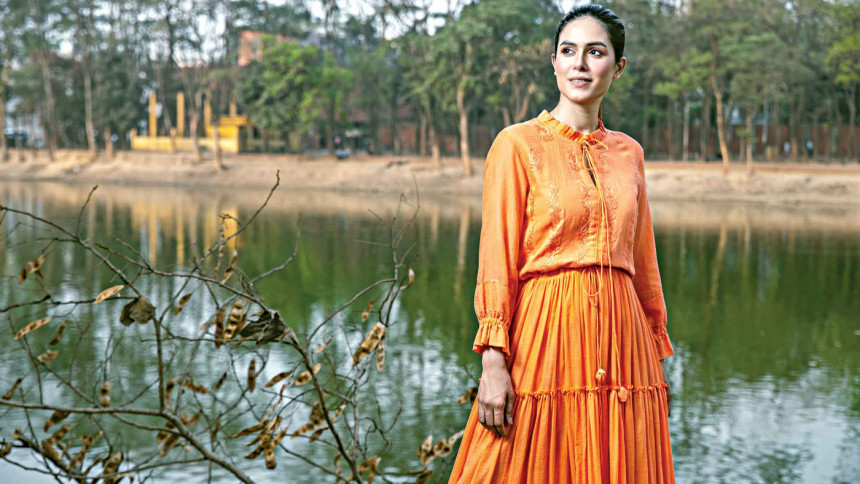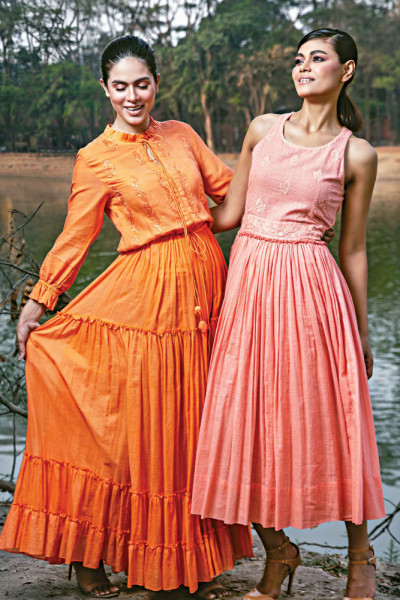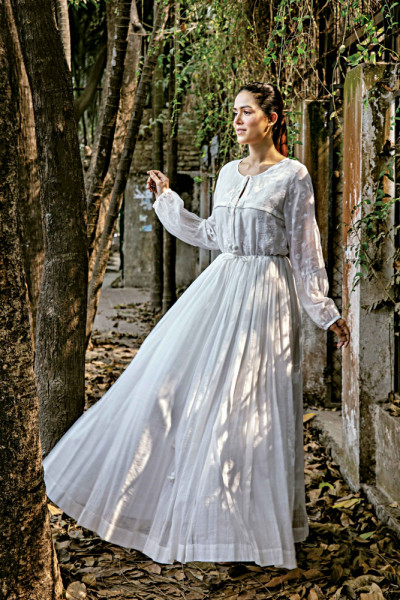The next step for Studio Mayasir


Most of us are already aware of the negative effects of mass-produced fashion. But is awareness good enough to make a recognisable change? To start afresh, we must be able to go back to our roots and connect the weavers to the end consumers. We must embrace slow fashion, understand what it means and find ways to blend the process into our modern lives. One such fashion outlet that has already embraced the age-old system is Studio Mayasir by Maheen Khan.
Star Lifestyle recently spoke with Khan to understand the basics of slow fashion and what it takes to revive the ancestral traditions.
What is Studio Mayasir involved with at the moment?
Our fashion outlet has stopped all kinds of retail operations and has completely shifted focus towards developing lines that have a global acceptance. We are doing home collections and fashion accessories like scarves, which have a greater international appeal. We are making cushions, runners, and even dresses using handloom and handcrafted materials. So basically, today, Studio Mayasir has more of a global essence.
Is being global synonymous to being trendy?
We believe in fashion in general, but not in the term 'trendy,' because we advocate for slow fashion which literally means — timelessness. Our collections are one that you can wear anytime and anywhere and yet look in-sync with the modern-day contemporary look.
Studio Mayasir's latest lines have simple designs, simple cuts that are foremost comfortable and minimalistic. Our designs indirectly resonate to being conscious, responsible, and active in promoting a better world.
You are always saying that you are an advocate for slow fashion. How do you define slow fashion?
Good question! Slow fashion is the complete opposite to the fast-paced, mill-produced fashion that we commonly see today. It involves the manufacture of clothes with the help of local artisans and use of eco-friendly materials, with the ultimate goal of preserving our heritage crafts and the environment. It's a win-win situation for all; our talented artisans get to earn their daily bread and butter, the country gets to preserve its heritage weaves and crafts, and customers get timeless and sophisticated end-products.

How is the new version of Studio Mayasir different from the past? Were you not always an advocate for slow fashion?
Yes, slow fashion always reigned the basics of our designing. However, previously, we did occasionally use some cottons and georgettes which were machine made, solely because the customers demanded them.
Today, things are different. We have embraced new ways to become a conscious citizen of the world. We have realised that the onus is partly on us to teach our clients the benefits of slow fashion. And if we do not initiate the momentum then the thought process will only get lost in translation. Someone has to begin the process, no matter how hard the future may be. Today, Studio Mayasir only promotes handloom items that are absolutely local, sustainable and eco-friendly.
What has been the major inspiration behind the impactful transformation?
We have taken part in the Paris Fashion Week, International Weavers Festival in Malaysia and many other major events in Thailand and USA. We spoke to many buyers in the process and learnt so much from them. And these shows were certainly an eye-opener for us. Because countries like Indonesia, Malaysia, Cambodia, Laos, Vietnam and India have already invested heavily on slow fashion and have been quite successful in reviving their old techniques to weaving and crafts. This has certainly encouraged us to move forward with the idea. If they can, why can't we?
So, where can we see Studio Mayasir next?
In the future, we would probably like to explore the Japanese market because their aesthetics are very much similar to ours. They do a lot of hand-crafted work which is relatable to our stitches, quilts, patterns and lifestyle. Plus, the Japanese value handcrafted work and our weaves. So, it is definitely a good market for the handloom industry of our nation.

A few words of wisdom for our readers?
First and foremost, I would like to say that we must know what our culture is all about. It includes hand quilting, our weaves, our figured muslins — Jamdani, indigenous peoples' crafts and handloom, taant, gamcha, lungi, Rajshahi silk, baul music, etc. It is okay to have works of international designers in your wardrobe, but you must also have unique works of your own country in the same wardrobe.
We are here to promote that. Through Fashion Design Council of Bangladesh (FDCB), we are trying to encourage our designers not to put foreign embellishments like chumki and puti on everything. For once, we can try highlighting our weaves only, which are gorgeous.
Having said all that, I would like to conclude by saying: We do not need too many things to look attractive, sometimes minimalism and simplicity is the foundation behind sophistication. Let's try to rekindle our classy past, our heritage and try to realise what truly is a Bangladeshi cultural DNA. We need to get back to our roots before it is completely lost.
Photo: Shahrear Kabir Heemel
Models: Jolly, Tania
Stylist: Zabin Iqbal
Wardrobe: Studio Mayasir by Maheen Khan
Makeup and Hair: Ferdous Ahsan Orko and Shams Romon


 For all latest news, follow The Daily Star's Google News channel.
For all latest news, follow The Daily Star's Google News channel. 



Comments